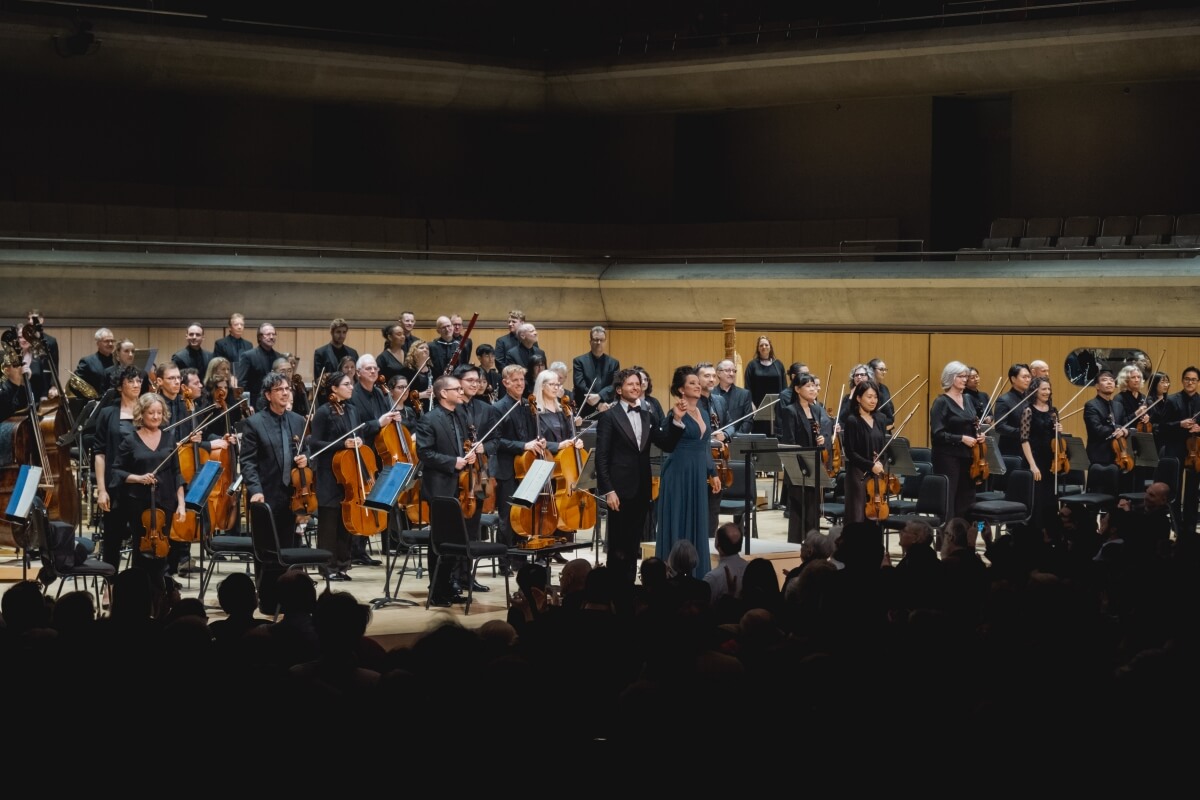Rufus Wainwright: A Lady’s Face (Sonnet 20); Paradis: Overture to Der Schulkandidat; Mozart: “Temerari! Sortite! … Come scoglio” from Così fan tutte, Ok. 588; Haydn: Scena di Berenice, Hob. XXIVa:10; Mahler: Symphony No. 4 in G Main. Toronto Symphony Orchestra, Gustavo Gimeno, conductor, Anna Prohaska, soprano. March 22, 2025 at Roy Thomson Corridor, Toronto.
Going to a live performance these days isn’t not like attending a sports activities sport, which begins with singing the nationwide anthem. The TSO appears to have taken up this development by taking part in O Canada to begin the night, giving a pleasant enhance of much-welcomed nationalistic pleasure.
Saturday’s live performance was a showcase of Soprano Anna Prohaska, TSO’s Highlight Artist this 12 months. The TSO has lately introduced its European tour in early 2026. Prohaska is among the visitor artists becoming a member of this tour, and a live performance in Madrid will function virtually the identical program.
As a nod to our nation, this system opened with Rufus Wainwright’s “A Lady’s Face” from 5 Shakespeare Sonnets. Sonnet 20, which extols a lady’s magnificence, is among the many finest identified of Shakespeare’s works of this style. Prohaska sings a easy melody from the choir loft, in opposition to hushed and delicate accompaniment from a celeste, strings and woodwinds, making a meditative spell.
Whereas Prohaska made her manner all the way down to the stage, the orchestra performed a rarely-heard overture by Maria Theresia von Paradis. Her opera “Der Schulkandidat” is her solely surviving orchestral work, which was rediscovered lengthy after her loss of life and never printed till 1992. The full of life and rhythmic work was performed with vibrant vitality and balanced concord from the orchestra.
Prohaska then sang snippets from two operatic works. Within the aria “Come scoglio” from Mozart’s Cosi fan tutte, the character of Fiordiligi reveals her loyalty to her fiancé by steadfastly rejecting the advances of males in disguise to check her faithfulness. Prohaska deftly nailed the quick scales and octave leaps with a bright-sounding coloratura.
Within the “Scena di Berenice” by Joseph Haydn, Prohaska used a extra mature voice to seize the emotional turmoil of Berenice, who’s overwhelmed with grief and despair as she faces the approaching loss of life of her lover. Her expressive singing was matched with intense taking part in from the orchestra.
Prohaska has a pure, angelic voice which was audible however not fairly loud sufficient to soar over the orchestra. From the place I sat within the mezzanine, I may hear the stunning melody however couldn’t make out the phrases. A part of the issue is the acoustics of Roy Thomson Corridor, and it’s troublesome for any soprano to compete in opposition to a 40-piece orchestra when they aren’t taking part in from a pit like on the 4 Seasons Centre.

Mahler No. 4
The night’s showpiece was Mahler’s Symphony No. 4 in G main. The themes of life, loss of life, and the afterlife are recurrent in Mahler’s works, typically with an undercurrent of darkness. Against this, the fourth symphony is a light-hearted, sunny piece which depicts a journey from the earthly to the heavenly, and of the afterlife as seen by the eyes of a kid. One can image kids taking part in, and virtually hear the sounds of sleigh bells in opposition to angels singing in heaven within the first motion.
The second motion is an unmistakable dance, however not fairly a cheerful one. Alas, Mahler’s darkish aspect remains to be current within the jarring and dissonant melodies. One distinctive component is using the “scordatura” violin, performed by visitor concertmaster Gregory Ahss, who needed to swap between two violins all through the motion.
Within the extremely romantic third motion, conductor Gustavo Gimeno painted a serene image of heaven, drawing some very expressive taking part in from the orchestra and highlighting the wealthy textures of Mahler’s rating. Gimeno’s glorious use of dynamic contrasts from pianissimo strings to thundering climaxes launched feelings in ways in which solely Mahler’s quintessential music can.
Prohaska returned for the ultimate motion, which relies on the tune “Das himmlische Leben” (The Heavenly Life). The textual content references a litany of saints and describes a blissful, childlike paradise with heavenly feasts and joyful actions. Prohaska was at her finest, singing with a light-weight, clear, and harmless tone, with moments of whimsical humour. This was well-balanced by ethereal woodwinds and strings, creating a toddler’s imaginative and prescient of heaven. The motion ends not in a bang, however in a whimper. For dramatic results, there was a chronic pause and silence earlier than Gimeno put down his baton, and we may lastly launch our held breath.
Mahler’s Fourth can be performed in 4 of the 9 concert events within the TSO’s upcoming Europe tour. If this live performance was any indication, Europe is in for a deal with.
As a aspect observe, Saturday’s live performance additionally celebrated the profession of Amy Joanou-Canzoneri, who’s retiring after 30 years with the TSO. The violinist was greeted with a heartwarming speech from Gimeno and standing ovations from the viewers. Congratulations and Blissful Retirement, Amy.
Are you trying to promote an occasion? Have a information tip? Have to know the most effective occasions occurring this weekend? Ship us a observe.
#LUDWIGVAN
Get the each day arts information straight to your inbox.

